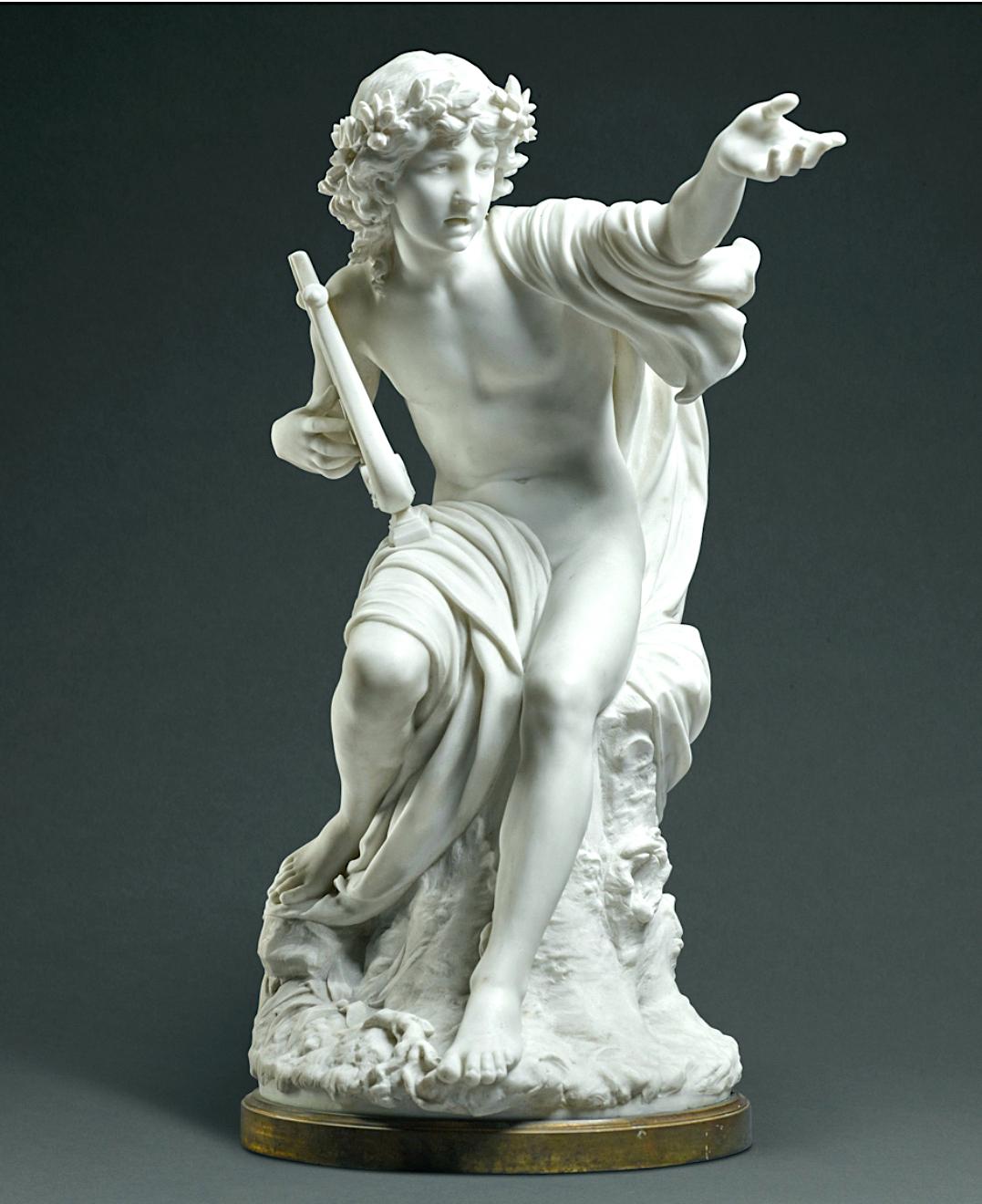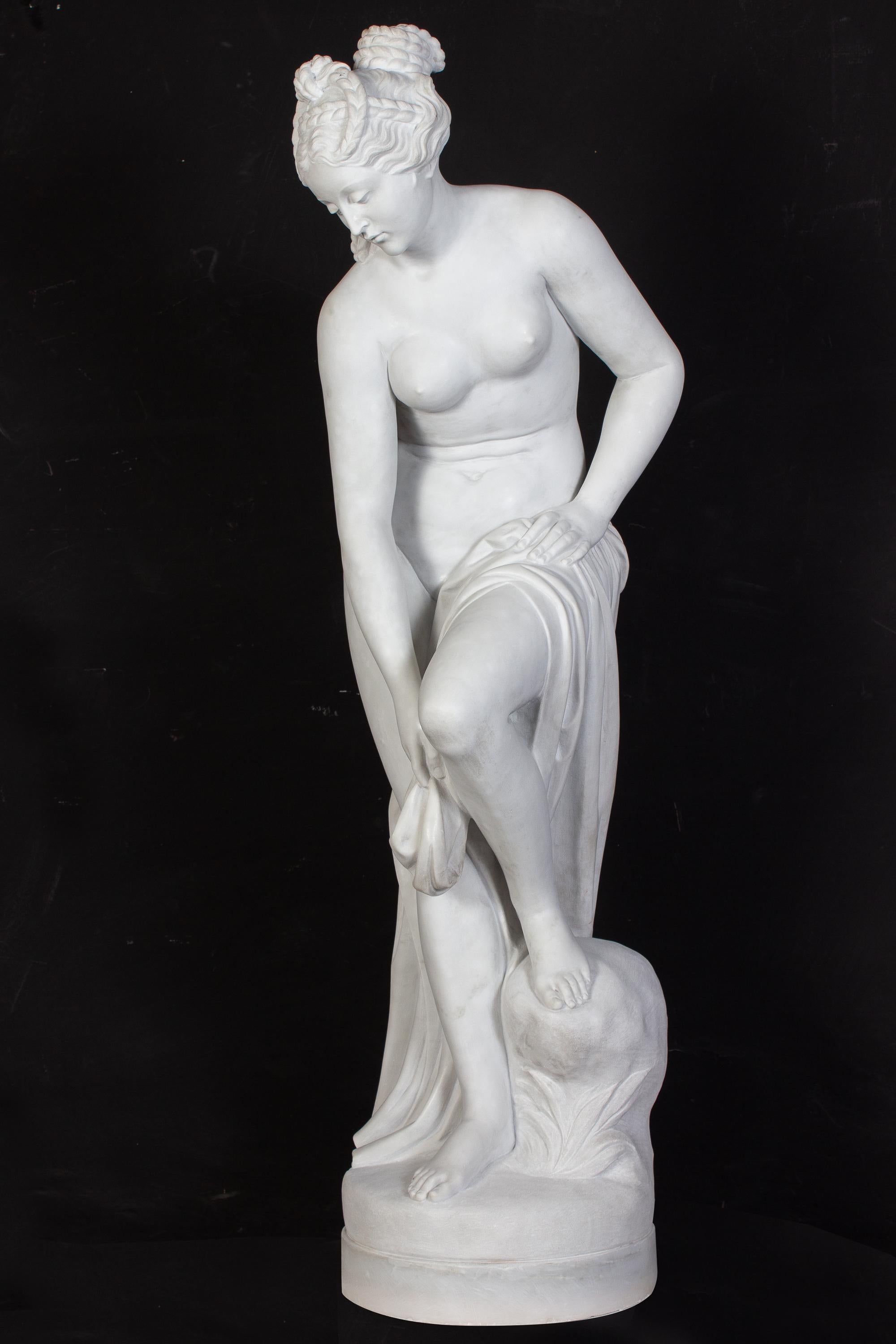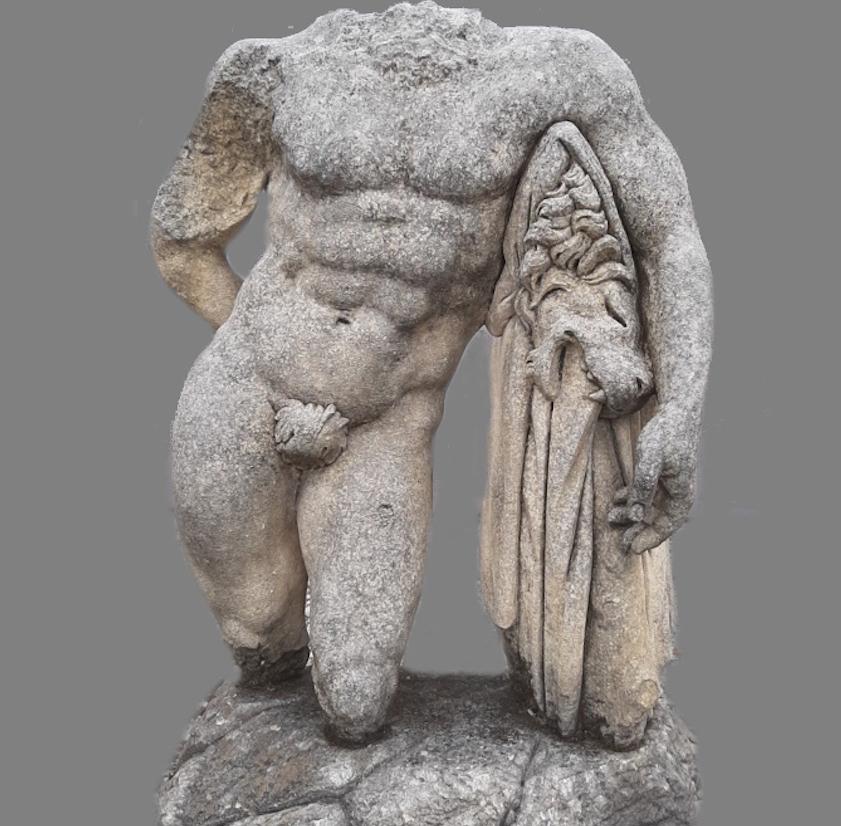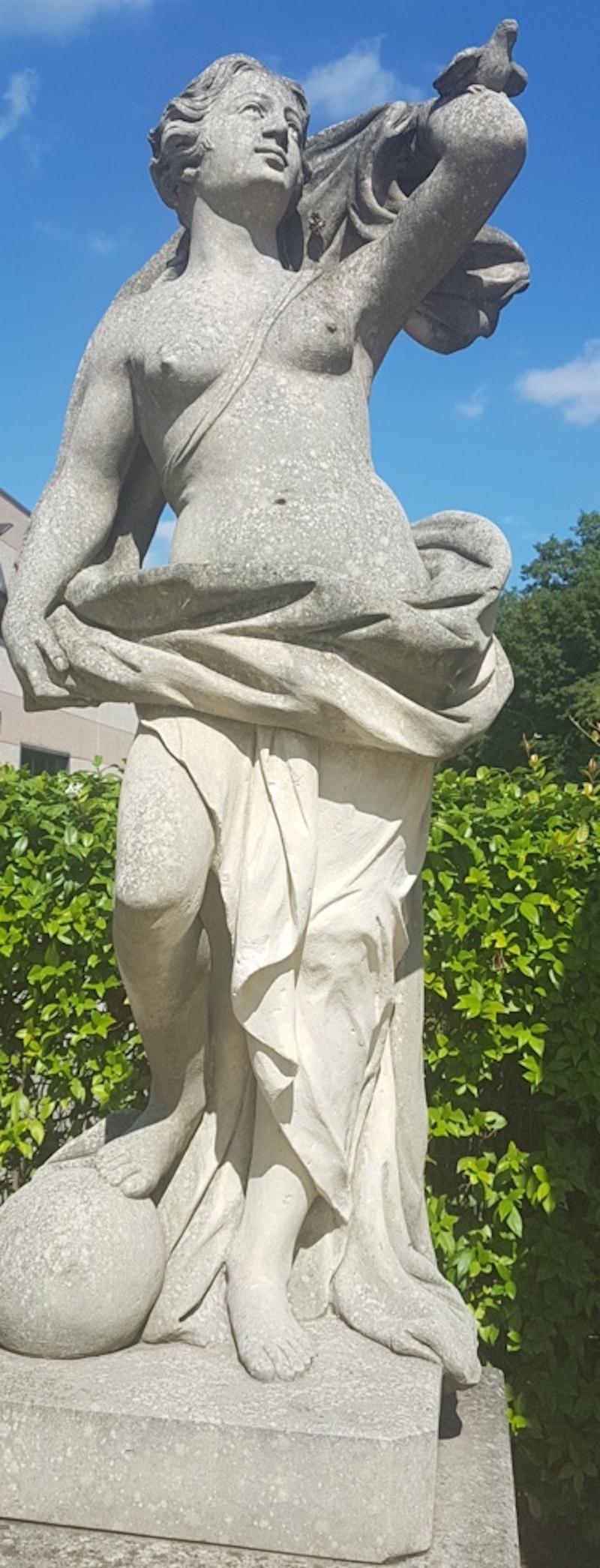Items Similar to Daytime, marble sculpture
Want more images or videos?
Request additional images or videos from the seller
1 of 17
James PradierDaytime, marble sculpturecirca 1840
circa 1840
About the Item
"Daytime" by James PRADIER (1790-1852)
Rare sculpture made in white Carrara marble
France
circa 1840
height 100 cm
diameter of base 29 cm
Listed in "Catalogue raisonné, James Pradier et la sculpture française de la génération romantique", C. Lapaire, Sik Isea, 5 Continents éditions, Milan, 2010, page 441, n°538.
Biography :
Jean-Jacques Pradier, known as James Pradier (1790-1852) was a sculptor and painter from Geneva who made his career in France. Following the fashion of the time, he adopted the English name of "James". He entered the public school of drawing in 1804. In 1807 he joined his brother Charles-Simon Pradier in Paris, where he worked for François-Frédéric Lemot before being admitted to his studio at the Fine Arts school in Paris, as well as in the workshops of painters Charles Meynier and François Gérard.
In the 19th century, several currents and styles coexisted in the arts. It is also difficult to bring together works that are sometimes very different under the same label. Academic rules were still relevant at that time and many artists thus took up ancient subjects often inspired by mythology as well as a neo-classical aesthetic and used marble, a material referring to Antiquity. But, while some artists took up its exact characteristics, others allowed themselves to be influenced by parallel movements. This was the case of Pradier who mixed in his works both an ancient art and an art inspired by nature. Indeed, the latter strongly marked by his stay in Rome, was inspired all his life by themes inspired by mythology and ancient stories but with an emphasis on figures (the major theme of his work). He represented his characters with ancient attributes and clothes. However, his works were also marked by different romantic undertones. He revealed the melancholy and the drama that make the link with the story of his heroes. Finally, the flesh of his characters, sensitive under the drapes, were always marked by a strong naturalism and a certain sensualism.
- Creator:James Pradier (1790 - 1852)
- Creation Year:circa 1840
- Dimensions:Height: 39.38 in (100 cm)Width: 14.97 in (38 cm)
- Medium:
- Movement & Style:
- Period:1840-1849
- Condition:
- Gallery Location:PARIS, FR
- Reference Number:

About the Seller
5.0
Vetted Seller
These experienced sellers undergo a comprehensive evaluation by our team of in-house experts.
Established in 1992
1stDibs seller since 2023
Typical response time: 17 hours
- ShippingRetrieving quote...Ships From: PARIS, France
- Return PolicyA return for this item may be initiated within 3 days of delivery.
More From This SellerView All
- BatherLocated in PARIS, FRBather by Etienne Hachenburger (19th-20th C.) Sculpture in white Carrara marble Signed on the side of the base "E. Hachenburger" A simiilar model was exhibited at the Paris Salon oh...Category
Early 1900s French School Nude Sculptures
MaterialsMarble
- The SongBy Félix CharpentierLocated in PARIS, FR"The Song" by Félix Charpentier (1858-1924) A very fine bronze sculpture with nuanced dark brown patina Signed "Fx. Charpentier" Cast by "E. Colin & Cie Paris" France around 1900 he...Category
Early 1900s Art Nouveau Figurative Sculptures
MaterialsBronze
- Diana with an arrowBy Albert-Ernest Carrier-BelleuseLocated in PARIS, FRDiana with an arrow by Albert-Ernest CARRIER-BELLEUSE (1824-1887) Bronze sculpture with a dual light and dark brown patina signed on the base "Carrier-Belleuse" inscribed on a front plaque "Diane à la Flèche par Carrier-Belleuse (Sculptr)" France circa 1870 height 83 cm arrow added probably in the 20th c. Biography : Albert-Ernest Carrier de Belleuse known as Carrier-Belleuse (1824-1887) was one of the most prolific artists of the century and had the greatest successes under the Second Empire, enjoying the personal support of Napoleon III. His work was greatly influenced by the style of the Italian Renaissance and that of the 18th century, which he helped to bring up to date. In 1837, the young Carrier-Belleuse apprenticed in the workshop of the engraver Bauchery. He was admitted soon after to the goldsmith Jacques Henri Fauconnier. Through François Arago, he met the sculptor David d'Angers who facilitated his admission to the School of Fine Arts. Carrier-Belleuse entered it in 1840. Noted for his skill by the great bronze companies in Paris such as Barbedienne and Denière, he soon received numerous orders for models for candelabras, pendulums, fittings for fireplaces, etc. In 1848, probably at the initiative of François Arago, who became head of state, he received his first public order for a small statue of "Mademoiselle Rachel singing La Marseillaise". In 1851, he appeared for the first time at the Salon of French Artists, where he presented two bronze medallions. From 1851 to 1855, Carrier-Belleuse stayed in England, in Stoke-on-Trent where he served as director of the modeling and drawing school of the Minton house, a large porcelain manufacturer. Back in France, Carrier-Belleuse moved to Paris in a large workshop located 15 rue de la Tour d´Auvergne. From 1857, he made regular sendings to the Salon and became famous thanks to the success of large marbles, such as the "Bacchante" exhibited at the Salon in 1863, and acquired by Napoleon III, "Angelica" (1866) or even "Hebe asleep" (1869). At the Salon of 1867, his group entitled "Messiah" earned him the medal of honor of sculpture. It was acquired by the State to adorn the Chapel of the Virgin in the Saint-Vincent-de-Paul church. Carrier-Belleuse acquired a great reputation in parallel for his terracotta busts which, in many respects, recall those of 18th century artists. He made portraits of a large number of celebrities of his time. He produced, among others, the busts of Napoleon III, Renan, Thiers, Grévy, Arago, Marguerite Bellanger, Théophile Gautier, Honoré Daumier, Delacroix, Hortense Schneider, Réjane… He also modelled numerous busts of mythological inspiration and historical and artistic portraits like Marie Stuart, Shakespeare or even Mozart. Carrier-Belleuse used and trained in his workshop in the rue de la Tour d´Auvergne many young talented artists such as Alexandre Falguière, Jules Desbois...Category
1870s French School Nude Sculptures
MaterialsBronze
- Snake CharmerBy Albert-Ernest Carrier-BelleuseLocated in PARIS, FRBronze sculpture with a nuanced dark brown patina signed on the base "A. Carrier" inscribed on a front plaque "Charmeuse de Serpents par Carrier-Belleuse" France circa 1860 height 80,5 cm Biography : Albert-Ernest Carrier de Belleuse known as Carrier-Belleuse (1824-1887) was one of the most prolific artists of the century and had the greatest successes under the Second Empire, enjoying the personal support of Napoleon III. His work was greatly influenced by the style of the Italian Renaissance and that of the 18th century, which he helped to bring up to date. In 1837, the young Carrier-Belleuse apprenticed in the workshop of the engraver Bauchery. He was admitted soon after to the goldsmith Jacques Henri Fauconnier. Through François Arago, he met the sculptor David d'Angers who facilitated his admission to the School of Fine Arts. Carrier-Belleuse entered it in 1840. Noted for his skill by the great bronze companies in Paris such as Barbedienne and Denière, he soon received numerous orders for models for candelabras, pendulums, fittings for fireplaces, etc. In 1848, probably at the initiative of François Arago, who became head of state, he received his first public order for a small statue of "Mademoiselle Rachel singing La Marseillaise". In 1851, he appeared for the first time at the Salon of French Artists, where he presented two bronze medallions. From 1851 to 1855, Carrier-Belleuse stayed in England, in Stoke-on-Trent where he served as director of the modeling and drawing school of the Minton house, a large porcelain manufacturer. Back in France, Carrier-Belleuse moved to Paris in a large workshop located 15 rue de la Tour d´Auvergne. From 1857, he made regular sendings to the Salon and became famous thanks to the success of large marbles, such as the "Bacchante" exhibited at the Salon in 1863, and acquired by Napoleon III, "Angelica" (1866) or even "Hebe asleep" (1869). At the Salon of 1867, his group entitled "Messiah" earned him the medal of honor of sculpture. It was acquired by the State to adorn the Chapel of the Virgin in the Saint-Vincent-de-Paul church. Carrier-Belleuse acquired a great reputation in parallel for his terracotta busts which, in many respects, recall those of 18th century artists. He made portraits of a large number of celebrities of his time. He produced, among others, the busts of Napoleon III, Renan, Thiers, Grévy, Arago, Marguerite Bellanger, Théophile Gautier, Honoré Daumier, Delacroix, Hortense Schneider, Réjane… He also modelled numerous busts of mythological inspiration and historical and artistic portraits like Marie Stuart, Shakespeare or even Mozart. Carrier-Belleuse used and trained in his workshop in the rue de la Tour d´Auvergne many young talented artists such as Alexandre Falguière, Jules Desbois...Category
1860s French School Figurative Sculptures
MaterialsBronze
- Nature unveiling in front of ScienceBy Louis Ernest BarriasLocated in PARIS, FRNature unveiling in front of Science by Louis-Ernest Barrias (1841-1905) Bronze sculpture with multiple patina. Signed "E. Barrias" on the side of the base cast by "Susse Frères" (foundry mark and stamp) The model of this statue was commissioned in 1889 to decorate the new medical school in Bordeaux. When he had finished the first version in white marble for the school, Barrias designed a second marble and onyx statue in 1899 for the ceremonial staircase of the Conservatoire des Arts et Métiers in Paris. France circa 1900 height 58 cm Biography : Louis-Ernest Barrias (1841-1905) was a French sculptor . He came from a family of artists. His father was a porcelain painter and his older brother, Felix-Joseph Barrias, a recognized painter. Louis-Ernest Barrias entered the School of Fine Arts in Paris in 1858, he abandoned painting to move towards sculpture under the direction of François Jouffroy. In 1864, he won the Prix de Rome, on the theme of "The Foundation of Marseille", and was engaged on the site of the Paris Opera house. He later produced many sculpted works, most of them in marble. In 1881, Louis-Ernest Barrias was awarded a medal of honor of the fine arts and named knight of the Legion of Honor in 1878, then promoted officer in 1881 and commander in 1900. The artist replaced Auguste Dumont at the Institute in 1884, then succeeded Jules Cavelier as a professor at the School of Fine Arts, where, among his most notable students, there were Victor Ségoffin, Charles Despiau and Paul Landowski.Category
Early 20th Century Art Nouveau Figurative Sculptures
MaterialsBronze
- Woman taking off her shirtLocated in PARIS, FRWoman taking off her shirt by James PRADIER (1790-1852) Bronze with a nuanced brown patina cast by SOYER and INGE France circa 1850 height 28,5 cm Biography : Jean-Jacques Pradier...Category
1850s French School Nude Sculptures
MaterialsBronze
You May Also Like
- ORPHEUS Neoclassical White Marble Sculpture 19' CenturyLocated in Rome, ITUnique Carrara white marble finely carved sculpture of Orpheus , Mythological personification of the eternal love and art. Henry Dasson French 1825 - 1896 Orpheus white marble, on a...Category
19th Century Academic Figurative Sculptures
MaterialsMarble
- ORPHEUS Neoclassical White Marble Sculpture 19' CenturyLocated in Rome, ITUnique Carrara white marble finely carved sculpture of Orpheus , Mythological personification of the eternal love and art. Henry Dasson French 1825 - 1896 Orpheus white marble, on a gilt bronze base 75.5cm., 29 3/4 in. overall The renowned Parisian maker of gilt-bronze mounted furniture, Henry Dasson, began his career as a bronze sculptor. Occasionally marbles with his signature have appeared on the art market. It is likely that these were made in his workshop at 106, rue Vielle du Temple, which specialised in the production of bronze artifacts and clocks. Dasson's success was such that he was made a Chevalier de la Légion d'honneur in 1883 and was awarded the Grand Prix Artistique at the Paris 1889 Exposition Universelle. In the Greek myth Orpheus, son of the muse Calliope and Apollo – or of the king of Thrace, Eagro – is the poet par excellence, the personification of song. With his lyre and his words he manages to seduce men, animals of all species and even trees, stones and the sea. With the strength of his verses he moves, softens, excites, touches the soul and the fibers of those who have the opportunity to listen to him. Orpheus falls in love with the nymph Eurydice and marries her. Yet the fate of the two lovers...Category
19th Century Academic Figurative Sculptures
MaterialsMarble
- Fabulous Neoclassical Marble Sculpture of Bathing Venus 1880'Located in Rome, ITLate 19th century French finely carved white Carrara marble figure of Bathing Venus . The marble base is not included in the price. AFTER CHRISTOPHE-GABRIEL ALLEGRAIN (FRENCH, 1710-1795): A 19TH CENTURY MARBLE FIGURE...Category
1880s Academic Nude Sculptures
MaterialsMarble
- Pair Italian Limestone Garden Sculptures with CornucopiaLocated in Rome, ITFinely carved mythological subject in limestone with Cornucopia associated with the harvest, prosperity, or spiritual abundance. Excellent condition from an estate of Veneto. Measur...Category
20th Century Academic Figurative Sculptures
MaterialsLimestone
- Hercules Italian Stone Sculpture of Classical Torso with BaseLocated in Rome, ITThis reproduction of a classical Hellenistic sculpture of Hercules . A timeless piece for interior and a garden decoration. We can raise with a base on request .Category
20th Century Academic Figurative Sculptures
MaterialsLimestone
- Italian Limestone Garden Sculptures of Aria a Roman GoddnessLocated in Rome, ITFinely carved mythological subject in Lecce limestone of Aria a Roman Goddness . Excellent condition from an estate of Veneto. Measurements: Statue cm 160, base cm 85.Category
20th Century Academic Figurative Sculptures
MaterialsLimestone





